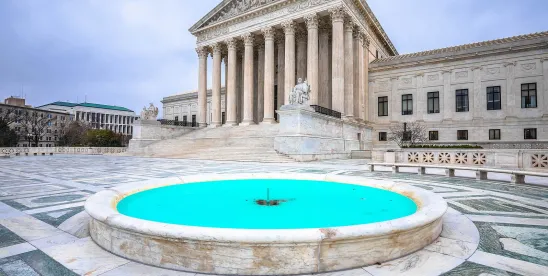In a landmark ruling with far-reaching consequences for federal agencies and the regulated community, the Supreme Court overturned the 40-year-old Chevron doctrine. Loper Bright Enterprises v. Raimondo, decided on June 28, 2024, fundamentally reshapes administrative law, eliminating the requirement that courts defer to agencies’ interpretations of ambiguous statutes. Instead, courts must exercise “independent judgment” in determining the meaning of statutory provisions, although they may still “seek aid” from well-reasoned or long-standing interpretations by agencies. This shift in the nature of judicial review marks a significant victory for those challenging federal regulations. It is expected to usher in a new era of greater scrutiny of agency actions and perhaps a different approach to law-making by Congress.
AGENCIES NO LONGER HOLD A PRIVILEGED POSITION IN STATUTORY INTERPRETATION
The Chevron doctrine, established in 1984 in Chevron U.S.A., Inc. v. Natural Resources Defense Council, Inc., directed courts to defer to an agency’s reasonable interpretation of an ambiguous statute that it administers. This doctrine has been a cornerstone of modern administrative law, shaping how courts review agency decisions and regulations.
The Supreme Court’s 6-3 decision in Loper Bright decisively overrules the longstanding Chevron doctrine, signaling a fundamental shift in courts’ oversight of federal agencies. As Chief Justice John Roberts declared, “Chevron is overruled.” The Court held that the Administrative Procedure Act requires courts to exercise “independent judgment” in determining whether an agency’s actions align with its statutory authority. In other words, courts must “independently” interpret the statute and effectuate the will of Congress. Going back to basics, the Courts must use the “traditional tools of statutory construction” to resolve statutory ambiguities and find the “best meaning” of the statute. By overturning Chevron, the Court explained that it was returning to “the traditional understanding of the judicial function.”
Courts may still look to an agency’s interpretation of a statute for guidance, particularly if it is long-standing or well-reasoned. In some cases, where the agency’s interpretation rests on “factual premises” within its expertise, an agency’s interpretation may even be “especially informative.” But in all cases, the Court has the final say about what the law means; the agencies will be given what appears to amount to “respectful consideration” under Skidmore v. Swift & Co, a pre-Chevron mode of analysis that left the ultimate interpretive authority with the courts.
This new interpretative methodology levels the playing field, allowing regulated entities to offer interpretations to resolve statutory ambiguities—interpretations which may now be given greater weight. It empowers regulated entities to challenge agency decisions with reasoned arguments and allows courts to play a more active role in scrutinizing federal regulations.
CONGRESS MAY STILL EXPRESSLY DELEGATE CERTAIN AUTHORITY TO AGENCIES
Under this post-Chevron framework, Congress retains the ability to delegate authority to federal agencies expressly, but it must clearly define the scope of that authority. Courts will honor such delegations when explicitly stated but will no longer infer delegation from statutory silence or ambiguity. Courts will also “police” the boundaries of any express delegations to ensure that agencies remain within the confines of the APA. In that sense, the Court’s ruling demands a more precise approach by Congress and is likely to discourage broad, vague grants of authority to agencies.
Despite overturning Chevron, the Supreme Court emphasized that the ruling does not invalidate prior cases decided under the Chevron framework. The specific holdings of those cases, including the Clean Air Act holding of Chevron itself, remain valid under the principle of stare decisis. This holding creates an additional hurdle for challenging existing interpretations based solely on the change in interpretative methodology, although stare decisis may not be an insurmountable obstacle in some cases.
The ruling drew criticism from three dissenting Justices, who argued that it further expands the Supreme Court’s power at the expense of the executive branch and agencies with specialized subject-matter expertise. The dissenting Justices noted that the ruling could enable judges to make policy decisions on contentious cultural issues like climate change, healthcare, and artificial intelligence. But the majority expressly rejects this, saying that “resolution of statutory ambiguities involves legal interpretation,” and that “task does not suddenly become policymaking just because a court has an ‘agency to fall back on.’”
KEY TAKEAWAYS
While the full impact of the decision will unfold over time, here are some key takeaways:
Policy Life Cycle Impact
This ruling will affect the entire “policy life cycle,” including, and beginning with, how bills are drafted and what delegation language is used (i.e., the specificity of the delegation language); how regulated entities comment on rules before agencies and how agencies in the executive branch issue decisions; and most directly, the level of judicial deference given to agencies’ interpretations in the courts.
Empowerment of Regulated Entities
This ruling is expected to empower regulated entities, giving them more leverage in interpreting statutes and challenging agency actions. Conversely, post-Chevron, agencies will be left with less latitude in interpreting their own authority. This could lead to increased litigation and a shift in the balance of power between agencies and the entities they regulate.
Uncertainty for Existing Regulations
This decision may cast doubt on the validity of some existing agency interpretations and regulations that rely on broad or ambiguous statutory language. Agencies will need to be more circumspect in their rulemaking and provide clearer justifications for their interpretations—justifications that do not merely defend the purpose behind their rule but also their statutory basis.
Focus on Express Delegation
The ruling emphasizes the importance of clear and explicit delegation of authority from Congress to agencies. This may lead to more detailed and specific statutory language in future legislation and perhaps even the need to revisit existing legislation.
Potential for Increased Litigation
As regulated entities gain more leverage, we can anticipate a rise in legal challenges to agency actions, potentially leading to a flood of litigation seeking to invalidate future agency rules and adjudications.
LOOKING AHEAD
This landmark decision has introduced a new era of uncertainty, as the legal and regulatory landscape adapts to the post-Chevron world. The true impact of this ruling will likely be defined through years of litigation, as courts, agencies, and Congress grapple with its practical implications. Navigating this complex and evolving terrain will require the expertise of legal professionals who can help businesses, agencies, and policymakers understand and respond to the shifting legal landscape.








 />i
/>i
